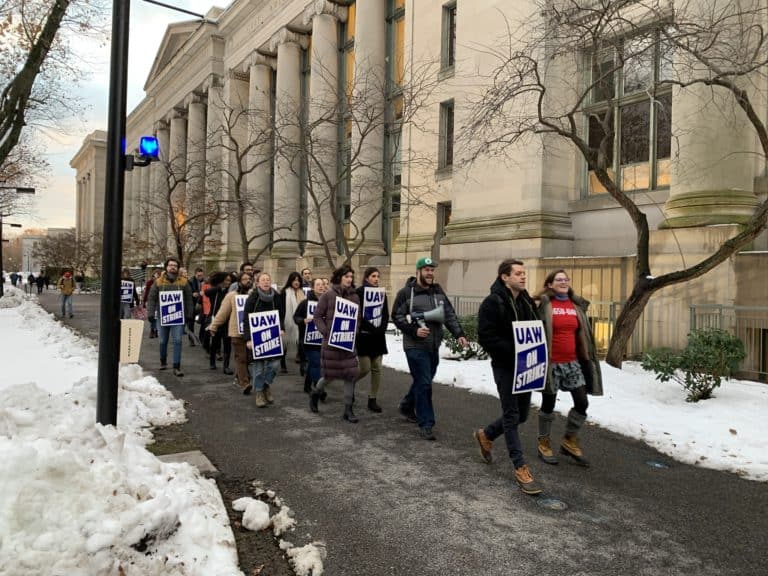
Cynthia Estlund is the Crystal Eastman Professor of Law at the New York University School of Law.
This is part three of a three-part series. See part one here, and part two here.
Questions about sectoral co-regulation abound. First, there’s the question of how to define a “sector”—e.g., along product market or labor market lines: A hospital janitor can be both a health care worker and a maintenance worker. The puzzle of overlapping sectors might loom large if we envisioned an economy-wide system of sectoral labor standards. But we don’t. Sectoral standards can be partial and, again, opportunistic. Sectoral bargaining happens, where it does, when workers share common interests, and a union organizes enough of them to put economic clout behind employee demands. Sectoral co-regulation similarly requires a reasonably cohesive and organized group of workers—like fast-food workers in New York and California—to create an effective political demand for higher standards.
Another question concerns the geographic scope of sectoral standards. Political and legal constraints point toward state or local sectoral standards; and those can be sustainable where the product market in a sector is local or regional—as with health care, hospitality, and domestic work, for example. Higher sectoral standards (like higher collectively-bargained wages and benefits) are more constrained in sectors like manufacturing where product markets are national or even global, or like brick-and-mortar retail where online substitutes are increasingly available.
One might wonder, however, what justifies higher sectoral minimum standards, especially wages. In principle, minimum wages should reflect the cost of reproducing workers’ labor power at a decent minimum standard of living. (The current federal minimum hourly wage of $7.25 flunks that standard, even for a single adult, everywhere in the United States.) It makes sense for minimum wages to vary geographically, as they do given state and local lawmaking; but why should they higher in one sector than another? The answer may lie in the theory behind collective bargaining, which was meant to enable workers to raise wages and benefits above the legal floor, and to capture a fair share of firm revenues, in firms and sectors where higher productivity and market conditions allowed. Sectoral regulation of wages can thus do some of what collective bargaining was meant to do.
Worker advocates might worry that sectoral standard-setting will compete with and undercut unions and enterprise-based collective bargaining. And though there is no inherent incompatibility between sectoral standards and higher collectively bargained standards at the enterprise level, some workers might get enough of what they want through sectoral regulation to discourage them from undertaking the risks and costs of organizing a union or striking. On the other hand, higher sectoral standards can sometimes facilitate organizing and bargaining at the enterprise level by raising the wage floor for non-union competitors and muffling employers’ incentive to resist unionization. Recall that the FLSA itself was meant to complement collective bargaining both by protecting workers who were unlikely to form effective unions and by raising the floor from which workers could bargain collectively. Sectoral standards might do both of those things even better in some settings.
One might also worry that sectoral labor standards will detract from efforts to raise the jurisdiction-wide floor, especially for wages. If subgroups of workers with political juice can gain higher wages for themselves, that might deplete the coalition needed to raise minimum wages for the more marginalized workers that remain. Stated differently, drawing organized worker’s activism into sectoral channels might detract from class-wide solidarity. But the tension between particularistic objectives and class-wide solidarity would seem to be even greater in the case of enterprise-based collective bargaining, which focuses worker activism and solidarity on even narrower groups of fellow workers. Fortunately, solidarity is not a zero-sum affair. Moreover, raising sectoral standards might in some cases soften the political ground for, and demonstrate the feasibility of, higher jurisdiction-wide standards.
I don’t mean to dismiss the last two sets of concerns. The two dominant modes of labor standard setting—enterprise-based collective bargaining and jurisdiction-wide minimum standards—might be different enough from each other to limit the competition between them. Sectoral regulation of labor standards in some ways splits the difference between those two dominant modes, and probably poses some greater risk of competition with both of them. But it is largely the advantages of sectoral regulatory strategies relative to those dominant strategies—that is, their ability to deliver significant gains for some groups of unorganized workers—that generate potential competition. The resulting risks seem worth taking if these new strategies allow us to raise labor standards for those left out of our collective bargaining system.
Workers need more leverage than they have within the existing, faltering system of enterprise-based collective bargaining, and more of a voice than they currently have in either formulating or enforcing legislated labor standards. Sectoral co-regulatory institutions, such as the state and local labor standards boards that are arising across the country, might combine some of the virtues and combat the respective shortcomings of both collective bargaining and conventional regulatory strategies for improving terms and conditions of work.
Many questions about sectoral co-regulation remain. To name a few: What can workers bring to sectoral standard-setting processes beyond the role they play in conventional political or administrative standard-setting processes? How can workers be represented in co-regulatory processes, and how can workers’ representatives and their co-regulatory activities be funded, absent formal union representation? And what about the legitimacy and integrity of a co-regulatory standard-setting process? Both collective bargaining and conventional regulation of labor standards are governed by well-established bodies of law—labor law and the law governing legislative and administrative processes, respectively. Co-regulation might be in need of its own governance principles. Elsewhere I try to refine these questions and suggest some tentative answers by looking at some examples of sectoral co-regulation, including the 2022 California FAST Act.
Genuine sectoral bargaining in the United States is a long-term aspiration if not a chimera. But sectoral co-regulation, with its old roots and new shoots, is gaining traction. Sectoral co-regulatory structures in which workers and their organizations have an institutionalized role could overcome the least-common-denominator problem of jurisdiction-wide minimum standards and fill part of the gap left by the decline of collective bargaining. Sectoral regulatory and co-regulatory structures and standards at the state and local level face few legal hurdles and surmountable political hurdles in many states and cities. Policy objections to the economic sustainability of higher sectoral labor standards at the state or local level will obviously vary by sector and locality, and will require attention within the standard-setting process. But part of the appeal of sectoral regulation is that it can vary by sector and locality.
Sectoral co-regulation is not a substitute for either collective bargaining or meaningful jurisdiction-wide minimum standards. But sectoral co-regulation has important virtues in a world in which workers need more tools and more leverage than existing labor and employment law affords them. Co-regulatory reforms at the sectoral level, where individuals share work and working conditions, can offer a focal point for collective action; they require workers to organize, identify common concerns, and collectively navigate political, legislative, and administrative processes to achieve shared ends. These campaigns and the co-regulatory processes that can result both spur and embody moments of democratic engagement and democratic control over workplace governance.






Daily News & Commentary
Start your day with our roundup of the latest labor developments. See all
November 28
Lawsuit against EEOC for failure to investigate disparate-impact claims dismissed; DHS to end TPS for Haiti; Appeal of Cemex decision in Ninth Circuit may soon resume
November 27
Amazon wins preliminary injunction against New York’s private sector bargaining law; ALJs resume decisions; and the CFPB intends to make unilateral changes without bargaining.
November 26
In today’s news and commentary, NLRB lawyers urge the 3rd Circuit to follow recent district court cases that declined to enjoin Board proceedings; the percentage of unemployed Americans with a college degree reaches its highest level since tracking began in 1992; and a member of the House proposes a bill that would require secret ballot […]
November 25
In today’s news and commentary, OSHA fines Taylor Foods, Santa Fe raises their living wage, and a date is set for a Senate committee to consider Trump’s NLRB nominee. OSHA has issued an approximately $1.1 million dollar fine to Taylor Farms New Jersey, a subsidiary of Taylor Fresh Foods, after identifying repeated and serious safety […]
November 24
Labor leaders criticize tariffs; White House cancels jobs report; and student organizers launch chaperone program for noncitizens.
November 23
Workers at the Southeastern Pennsylvania Transportation Authority vote to authorize a strike; Washington State legislators consider a bill empowering public employees to bargain over workplace AI implementation; and University of California workers engage in a two-day strike.